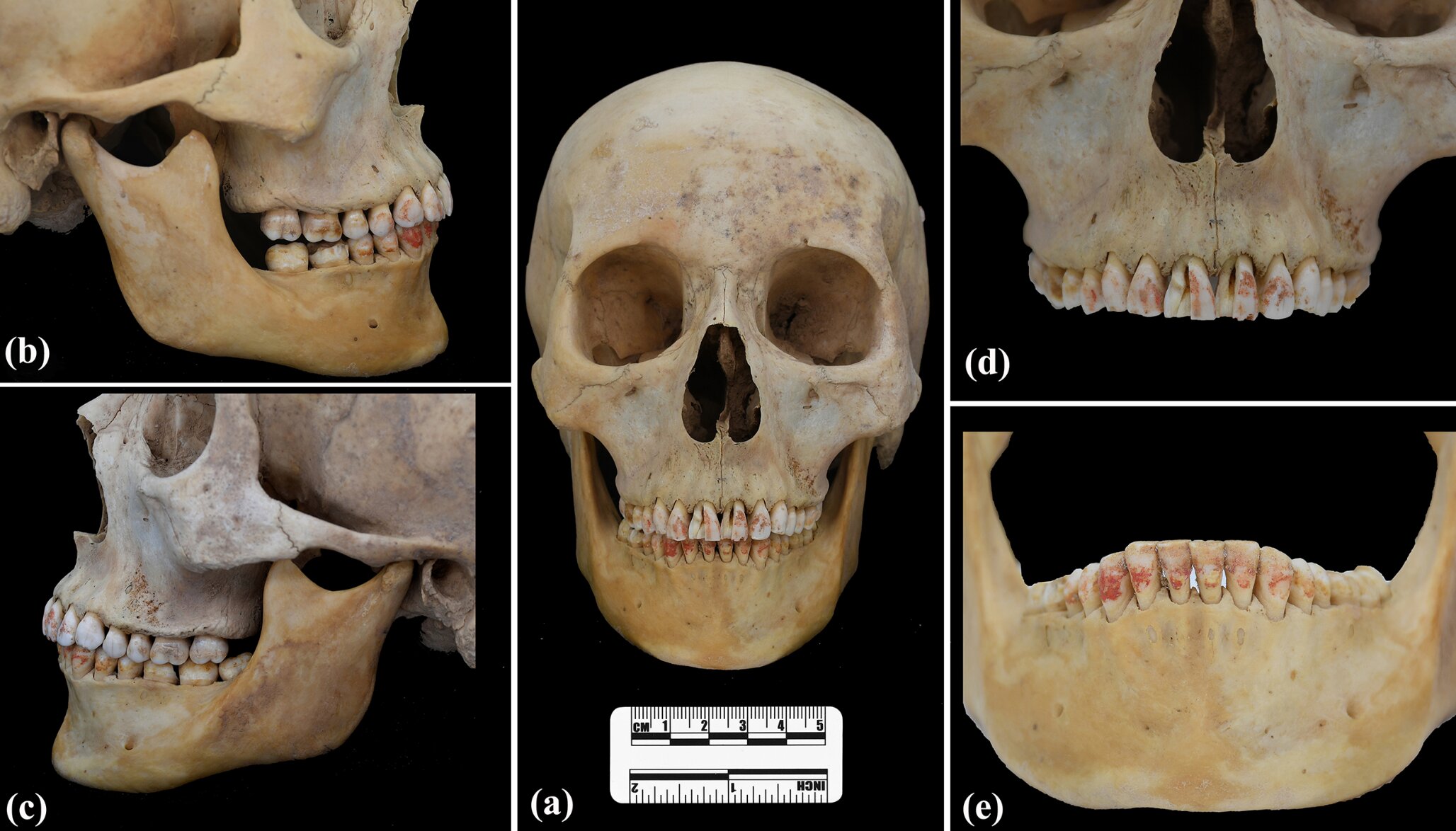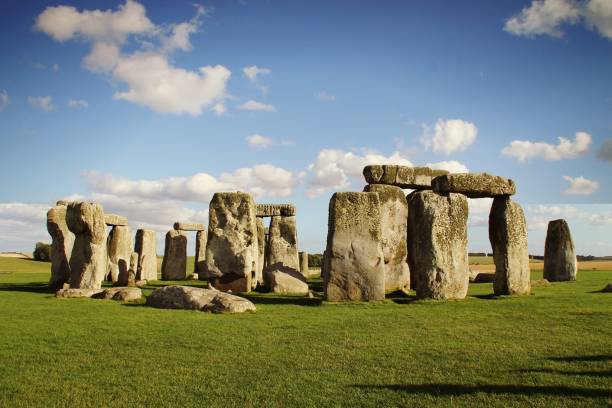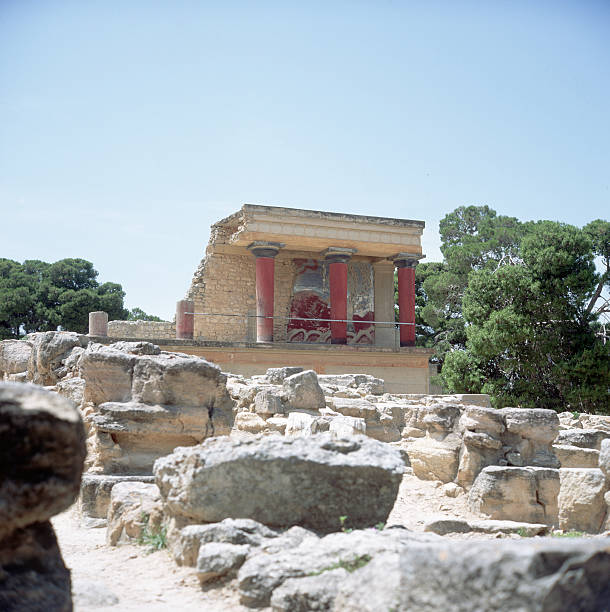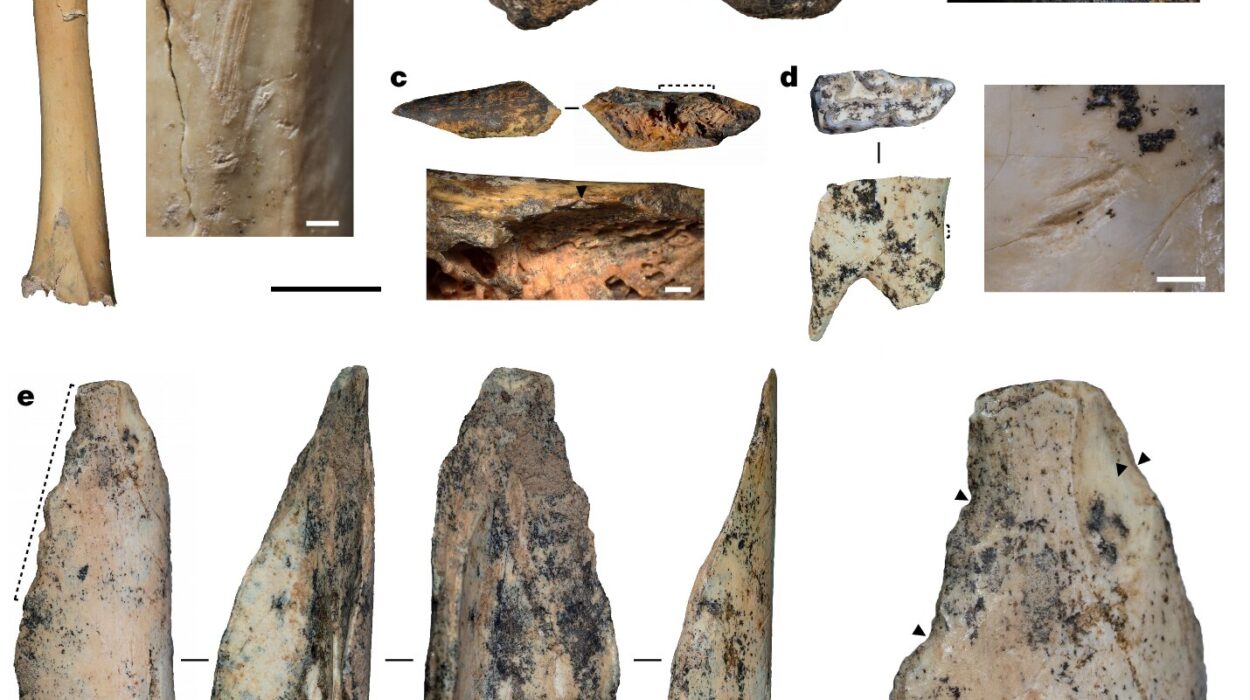Imagine uncovering an ancient grave and finding a woman with teeth stained a brilliant red. Not from decay, not from nature—but from something far more intentional, and deeply mysterious. This isn’t the plot of a novel or a scene from an adventure movie. This is real archaeology. And it’s rewriting what we know about ancient rituals on the Silk Road.
Researchers from Jilin University in China and Texas A&M University in the United States have documented an extraordinary find: the first known case of cinnabar-stained teeth in ancient history. This discovery, made in a burial dated to around 2,200 years ago in the Shengjindian Cemetery in Turpan, China, shines a new light on the ceremonial and cultural practices of the Iron Age peoples who lived along one of the world’s most legendary trade routes.
A Discovery That Dazzles—and Baffles
When archaeologists excavated Grave M11 at Shengjindian Cemetery, they unearthed more than just ancient bones and artifacts. Among the remains of four individuals, one stood out: a young woman, aged between 20 and 25, known in the research as M11:B. Her teeth were coated in a vivid red pigment. This wasn’t residue from food or the effects of burial soil. Laboratory analyses confirmed something remarkable: the pigment was cinnabar, a bright red mineral made of mercury sulfide, historically treasured for its color, rarity, and mystical significance.
This finding is a scientific first. While cinnabar has been found in many archaeological contexts worldwide—painted onto walls, used as body pigment, mixed into cosmetics, and sprinkled on the dead—there has never before been a recorded case of it staining human teeth. This young woman’s red-stained smile opens a window into a world we’re only beginning to understand.
The Mysterious Red Mineral: Cinnabar’s Journey Through Time
For millennia, cinnabar has held a powerful allure across civilizations. Mined sparingly due to its toxicity and scarcity, cinnabar’s rich, blood-red hue was as symbolic as it was stunning. In ancient China, it was used to decorate tombs, lacquerware, and ceremonial items. Alchemists prized it, believing it held life-giving properties, even the key to immortality. Across Europe, the Near East, and as far away as Central and South America, cinnabar surfaced in burial rites and religious practices, often linked to life, death, and the divine.
But this new discovery pushes the known boundaries of cinnabar use even further. Until now, there was no evidence to suggest it was ever directly applied to the teeth of the dead—or the living. What drove this Iron Age community to decorate this young woman’s teeth? Ritual? Fashion? Medicine? Or something more arcane?
Shengjindian Cemetery: A Cultural Crossroads
The setting for this discovery, the Shengjindian Cemetery, lies in the Turpan Basin of northwest China—a crucial hub along the ancient Silk Road. This site, associated with the Subeixi culture, dates to around 1000 BCE to 100 BCE. It was a cultural melting pot, where goods, ideas, and beliefs from distant lands intersected.
The cemetery itself holds 31 tombs, each revealing complex burial customs. Grave M11, where the cinnabar-toothed woman was found, was rich in grave goods: wooden objects, bone combs, ceramics, leather knife sheaths, gold earrings, and string ornaments. Other graves in the cemetery yielded silk fabrics, lacquer belt buckles, imitation turquoise glass beads, and a substance called “coal essence,” which some scholars believe was used as a cosmetic or medicinal product. These objects hint at far-reaching trade connections—possibly stretching as far as the Mediterranean—underscoring the globalized nature of this ancient society.
Unpacking the Science: How Did They Know It Was Cinnabar?
To confirm the nature of the red pigment, scientists turned to cutting-edge analytical techniques. Raman spectroscopy verified that the material was cinnabar (mercury sulfide), while X-ray fluorescence ruled out the possibility of environmental contamination after burial. Fourier transform infrared spectroscopy (FTIR) revealed protein-based compounds, suggesting an organic binder—maybe animal glue or egg white—was used to attach the pigment to the teeth deliberately.
This was no accident of time or nature. It was purposeful, intentional, and meaningful.
Why Stain Teeth Red? Ritual, Identity, or Magic?
The big question remains: why?
Throughout ancient China and Central Asia, cinnabar was revered for its symbolic properties. It was associated with life, death, and immortality. Some shamanistic traditions used red pigments in rituals believed to protect the soul or facilitate a journey to the afterlife. It’s possible that this young woman was part of such a ritual. Perhaps the cinnabar was applied to protect her in death, or maybe it marked her status as a shaman herself.
Alternatively, cinnabar might have been used as a cosmetic enhancement during her life, similar to how some cultures have historically used tooth filing or staining to indicate social rank or beauty. The red pigment may have signified something deeply personal, reflecting her identity, role, or beliefs within her community.
And then there’s the medicinal angle. Ancient medical practices sometimes included cinnabar for its supposed healing powers, despite its toxicity. Could this have been part of a medical treatment? Though less likely, it remains a fascinating possibility.
A Long Journey: Where Did the Cinnabar Come From?
Another intriguing mystery is the origin of the cinnabar itself. There are no natural deposits of cinnabar in the Turpan Basin. The nearest sources were far to the east in central China, or even further west in the Near East and Europe. This suggests the cinnabar was imported via trade routes—possibly the Silk Road itself, which by the Iron Age was already facilitating the exchange of goods, ideas, and cultural practices between East and West.
The young woman’s cinnabar-stained teeth not only connect her to local traditions but potentially link her community to an expansive network of trade and cultural exchange that stretched across continents.
The Red Princess of the Silk Road?
The researchers behind this discovery published their findings in the study titled “Red Princess of the Silk Road: The first-and-only known case of cinnabar-stained teeth in antiquity from the Iron Age Western Regions (202 BCE to 8 CE).” It’s a fitting moniker. This enigmatic young woman, with her red teeth and rich burial context, may have been someone of high status—a priestess, a healer, or a leader of her community. Her “red smile” could have been an emblem of power, reverence, or even a connection to the spiritual world.
What’s Next? The Quest for More Answers
This discovery raises more questions than it answers. Who was this woman? What role did she play in her society? Was the cinnabar application unique to her, or part of a broader (yet undiscovered) tradition?
Future research may include genetic analysis to determine her ancestry and mobility patterns, which could help clarify her cultural affiliations. Was she local to Turpan, or did she travel from afar? Further excavations at Shengjindian and other Silk Road sites may uncover more examples of cinnabar use or similar practices.
For now, she remains a tantalizing mystery—the Red Princess of the Silk Road—inviting us to wonder about her life, her death, and the ancient world she once inhabited.
A Red-Stained Legacy
This discovery is a vivid reminder that even in the ancient world, people found profound and creative ways to express their beliefs about life, death, and the beyond. Cinnabar-stained teeth may seem strange or even eerie to us today, but they speak of a deep cultural significance and a connection to larger spiritual ideas.
The young woman of Shengjindian Cemetery is a silent but powerful testament to the richness of human history—an individual whose final journey was marked with the vivid, enduring red of cinnabar.
And perhaps, through her red smile, she continues to tell her story.
Reference: Sen You et al, Red princess of the Silk Road – the first-and-only known case of cinnabar-stained teeth in antiquity from the Iron Age Western Regions (202BCE − 8CE), Archaeological and Anthropological Sciences (2025). DOI: 10.1007/s12520-025-02188-5






